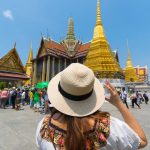CANBERRA – In a heated clash that has laid bare deep tensions around race and religion in Australia, far-right Senator Pauline Hanson has been formally censured and suspended from the Senate for seven sitting days after entering the chamber wearing a burqa.
The 71-year-old One Nation leader repeated her infamous 2017 stunt, and in doing so has reignited intense arguments over religious freedom, national security, and immigration, leaving politicians split and many Muslim Australians shaken.
The clash unfolded on Monday afternoon during routine Senate business. Hanson had been seeking permission to introduce a private member’s bill to ban burqas and other full-face coverings in public. Colleagues refused leave, blocking the move.
After leaving the chamber briefly, she returned covered head to toe in a black burqa, her identity hidden until she pulled it off and declared, “If you can’t see my face, how do you know I’m not a terrorist?”
The chamber erupted. Senate President Sue Lines ruled the outfit broke standards of dress and conduct, and ordered Pauline Hanson to remove it. Hanson refused. Proceedings stopped for an hour as Labor, Coalition, Greens, and crossbench senators lined up to condemn the spectacle.
Greens Senator Mehreen Faruqi, Australia’s first Muslim woman in federal parliament and fresh from winning a racial discrimination case against Hanson last year, was blunt. “This is blatant racism,” she said. ”
Parliament drips with racism now; it’s pathetic and dangerous.” Independent Senator Fatima Payman, also Muslim, called the act “disgraceful” and a direct attack on the dignity of women who wear veils.
By Tuesday, anger had hardened into formal punishment. Foreign Minister Penny Wong, who leads the Labor government in the Senate, moved a censure motion that passed 55–5. It declared that Pauline Hanson’s actions were “intended to vilify and mock people based on their religion” and “disrespectful to Muslim Australians.”
The sanction, excluding Hanson from seven consecutive sitting days and pushing into February 2026, is one of the strongest penalties handed to a senator in many years. It also blocks her from taking part in overseas parliamentary delegations for the current term.
Hanson showed no remorse at a fiery press conference. “They didn’t want to ban the burqa, yet they denied me the right to wear it. I’ll stand my ground, the people will judge me in 2028,” she said.
A Long Campaign Framed as Security
Pauline Hanson’s decision to wear a burqa in the Senate was not a one-off outburst. It is the latest move in a long campaign against Islamic dress and against Islam more broadly.
She first came to national attention in the 1990s as a fish and chip shop owner turned politician, railing against Asian immigration. In her 1996 maiden speech, she warned that Australia was being “swamped by Asians.”
By 2016, her focus had shifted to Muslims, claiming the country risked being “swamped by Muslims.” Her 2017 burqa appearance in the Senate drew a rare emotional rebuke from then Attorney-General George Brandis, who called it “appalling” and an insult to a religion practised by hundreds of thousands of Australians.
Her latest push for a burqa ban mirrors laws in France and repeats a theme she raised back in 2002, when she called for the niqab to be banned and pointed to cases in Chechnya where bombs were hidden under such garments. When reporters pressed her this week, she admitted there have been no known security incidents in Australia involving burqas.
“It’s about equality,” she argued. “If helmets are banned in banks, why not burqas? This oppressive garb risks our national security and women’s rights.” Some supporters, including a handful in the Nationals, quietly agree and see the bill as a stance against what they call “radical Islam.”
Critics describe it as scare tactics. Aftab Malik, Australia’s special envoy to combat Islamophobia, warned that the stunt “deepens safety risks for Muslim women” and fuels harassment and violence. “Veiled women are easy targets for bigotry,” he said.
One Nation, which holds four Senate seats, has framed the bill as a way to protect Australian culture. In a media release issued before Hanson’s appearance in the chamber, her office compared the proposal to laws in parts of Europe and argued that face coverings block reliable identification in places like airports, courts, and government offices. The bill, however, has little chance of success.
Labor and the Greens say it is discriminatory, and even moderate members of the Coalition are wary, concerned it will alienate key communities and moderate voters.
Pauline Hanson’s Immigration Battles
Pauline Hanson’s stunt comes at a time of intense public argument over immigration, population growth, and social change. Since 2020, record levels of skilled and humanitarian migration have driven Australia’s population to 27 million.
Net overseas migration under the Albanese government has reached around 500,000 people a year. Supporters argue this helps keep the economy growing and supports an ageing population. Critics like Hanson denounce what they call a “Big Australia” project that weakens national identity and strains services.
A growing Muslim population sits at the centre of many of these anxieties. The 2021 Census counted about 813,000 Muslims, or 3.2% of the population, up from 2.2% in 2011. The number has doubled since 2006, according to the Australian Bureau of Statistics. Research from the International Centre for Muslim and non-Muslim
Understanding suggests Muslims could make up around 4.9% of the population by 2050, driven by higher birth rates (above the national rate of 1.6) and migration from countries such as Lebanon, Pakistan, Afghanistan, and Iraq.
Around three-quarters live in Sydney and Melbourne. Suburbs like Lakemba are often dubbed “Little Lebanon” in popular discussion. This diversity, with Muslims from 183 countries, has reshaped food, festivals, and local business, but it has also become a focal point for culture wars.
The country looks split. Many inner-city residents in places like Sydney’s inner west or Melbourne’s Yarra Valley see multiculturalism as a national strength. Polls from the Scanlon Foundation show about 80% of Australians hold a broadly positive view of immigration.
In outer suburbs facing housing shortages, and in regions such as Hanson’s base in Queensland, worry is more common. A 2024 Lowy Institute survey found 40% of Australians believe immigration is too high. Muslims are often blamed in public debate for rises in crime or pressure on welfare, despite mixed evidence.
Conservative columnist Andrew Bolt summed up a common view last week, warning that “tidal waves of new tribes are dividing us” and hinting at the danger of parallel communities.
Anti-Muslim sentiment has simmered for years. It rose after the 2005 Bali bombings and spiked again after 9/11, then flared with global tensions over Israel and Gaza. A 2015 study found that Muslims in Sydney experience racism at three to five times the rate of the general public.
Far-right figures, from One Nation to former senator Fraser Anning, have used this climate to call for sharp limits on Muslim migration, in some cases referring to a “final solution”, language that horrified many Australians. Multicultural advocates like Mehreen Faruqi counter that integration is working in many areas.
About 37% of Muslims in Australia are born in the country, and many work in professional roles such as medicine, law, and technology. “We’re as diverse as Australia itself,” she says, “divided by ethnicity, not ideology.”
Events with a religious angle, such as the 2023 Sydney church stabbing or rallies where some fringe protesters chanted “gas the Jews”, have only hardened attitudes among Hanson’s supporters. Many rural and regional voters, unsettled by rapid social change and feeling left behind by globalisation, see Hanson as a straight talker.
Most inner-city professionals view her as clinging to a White Australia mindset that should have been left behind long ago. Economists warn that a sharp cut to migration could tip Australia towards recession.
At the same time, social researchers, including those at the University of South Australia, point to gaps in integration. Poor English skills, lack of support services, and sensationalist media coverage can worsen feelings of isolation among new arrivals.
A Fractured Federation on Show
As Pauline Hanson serves her suspension and hosts allies like Nationals MP Barnaby Joyce for dinner in her office, many on the left view the censure as a modest win. It sends a message about standards in parliament, yet also fuels Hanson’s story that she is a victim of political correctness and a “woke” elite.
That narrative plays well with a sizeable slice of the electorate, with polling suggesting around 20% of voters either back One Nation or share its nationalist outlook.
For many Muslim Australians, including Senator Payman, the outcome feels mixed. A formal rebuke offers some recognition and a sense of justice. At the same time, the language unleashed around the stunt, from social media abuse to talkback radio, shows that hostility has not gone away. “Finally, accountability,” Payman said, “but the hate persists.”
The fight over the burqa is about much more than a piece of clothing. It captures a wider struggle over who belongs, who gets to feel safe, and who has the power to define “Australian values.”
The Australian Federation of Islamic Councils often describes the country as a “successful multicultural experiment.” Pauline Hanson and her supporters insist that the experiment has gone too far. With an election on the horizon and pressure on housing, wages, and services, arguments over identity and migration are likely to intensify.
In a country built on many waves of newcomers, the central question hangs in the air. Who gets to decide what an Australian looks like, and whose face counts as part of the national story?












